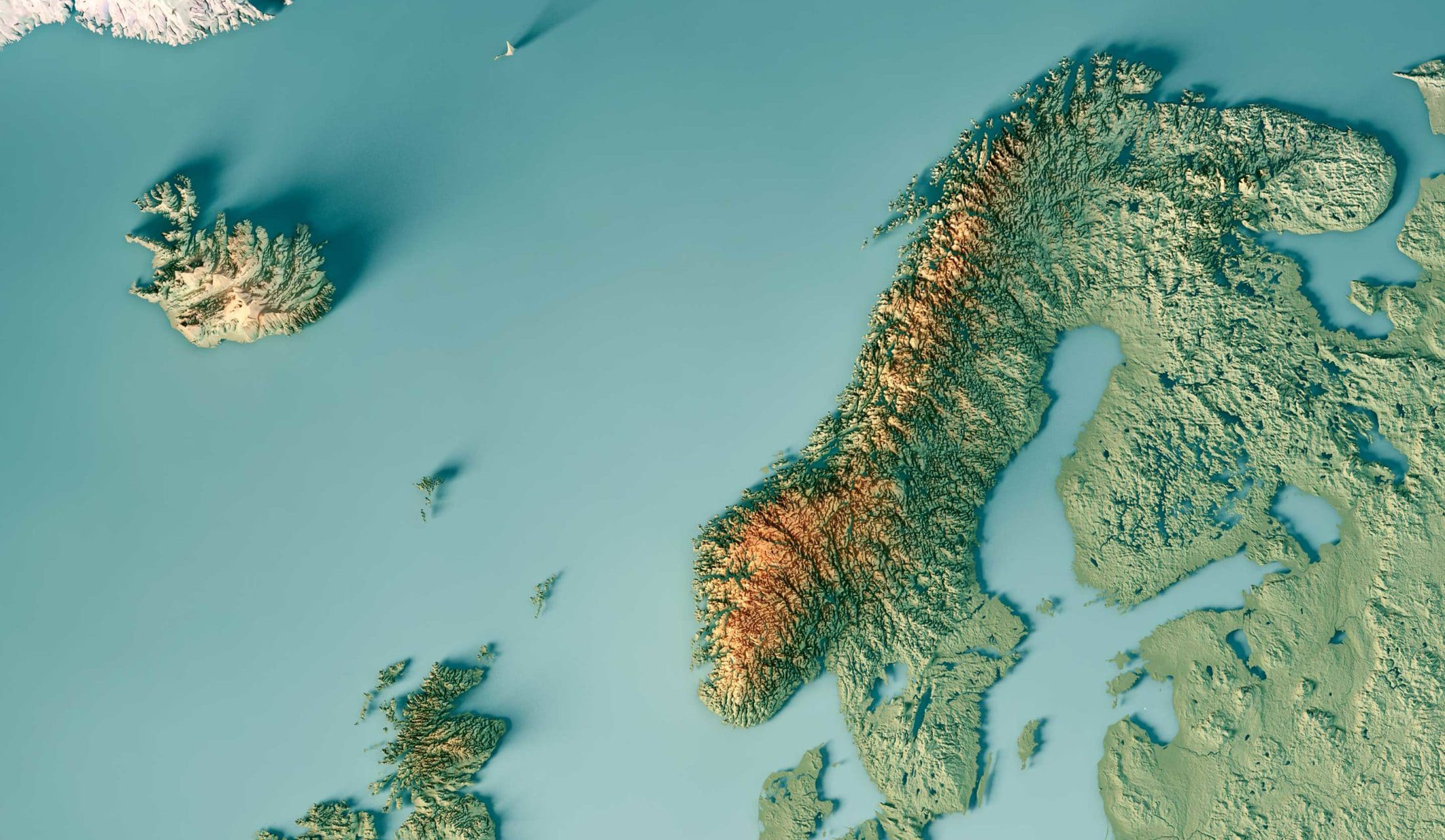The ongoing war in Ukraine has not only set formerly neutral Finland and Sweden on the path to NATO membership, the fighting and sanctions against Russia are also impacting the Nordic economies – but it’s not all negative.
Shared challenges
While we should always remember that the war is first and foremost a human tragedy with civilians and soldiers dying every day, it is also important for businesses to see how this ongoing crisis translates into new challenges and opportunities.
It’s clear that the initial impact of the conflict, which has interrupted supply lines and production and has entailed additional severe economic sanctions on Russia, has been mostly negative, not only for the countries close to the conflict zone, but to anyone who has conducted trade with the warring countries.
The Nordics have faced many of the same problems seen in other European countries in the wake of the invasion in March of last year, but to a somewhat lesser extent. The Nordic countries’ economies are better placed in terms of energy supplies: Norway has large deposits of natural gas in addition to hydro power, and Sweden and Finland have a substantial nuclear power sector, with 40% and 34% of their power supply originating from nuclear sources respectively. Despite lower inflation rates in the Nordic region, the rise in the price of gas has impacted businesses of all sizes, according to a report by Reuters. Together with the rise in the price of raw materials, it has led to inflationary pressures which in turn means that interest rates cannot be reduced, according to Arne Lohmann, Chief Analyst with Danske Bank.
Here we’ll look at some challenges and opportunities for the Nordic countries that have arisen since the outbreak of the war in Ukraine. Has the Nordic market, traditionally resilient and with high purchasing power, picked up some of the slack from reduced trade with Russia? How has the Nordic region been able to cope with reduced imports and exports from some of the warring countries, which have been interrupted either by sanctions or supply-line problems?
The Norwegian approach
In the midst of the talk of crisis and cataclysms, one country is quietly profiting from the higher energy prices: according to an article in The Economist, Norway’s revenue from the sale of oil, gas and electricity has increased from $50 bn to $200 bn a year.
However, due to depleting water stores, private consumers and businesses have had to pay more for their electricity even within Norway, something that is highly unpopular among the general population and has caused issues for some of the heavier industries that depend on cheap electricity to maintian profitability. Still, Norway’s willingness to sell gas has helped European countries to overcome their dependence on Russian gas. The discussion in Norway is that some of this surplus should be put towards the “green transition”, something that could lead to opportunities for businesses involved in this sector. The political will to push “green” innovations has already been demonstrated by the huge subsidies given to those who have purchased electrical vehicles – financed, perhaps ironically, by high tax revenues from the sale of oil and gas.
Titanium ore, which is used in the aerospace, aviation, automotive and medical industries, is another raw material where supply is being interrupted by the conflict. Until 2019, Ukraine was the world’s fifth largest supplier of this mineral, but this has since changed. In 2021, Norway became the second-largest mine producer of titanium in Europe, with an output of 220,000 metric tonnes. For those businesses that depend on or trade in this metal, Norway could represent an important alternative resource as the war drags on.
A report from The Confederation of Norwegian Enterprise (NHO), which looks at the consequences of the war for Norwegian businesses, acknowledges that there will be challenges, particularly in the short term, yet has an optimistic tone for the longer term, stating that “Europe is trying to decouple from Russian energy. This will mean great opportunities for the Norwegian economy and Norwegian businesses, as a big supplier of oil and gas as well as for example a producer of minerals and metals.”
The war has had a negative influence on the attitude of travellers. According to a survey carried out in September 2022 for Innovation Norway, where 4,646 potential travellers were asked about their travel intentions, more than half of the respondents said they have been influenced in a negative way by the price rises and insecurity. Families with children are those most affected by the price hikes, whereas consumers over the age of 50 and those with the highest incomes have been least affected.
However, in an article on the effect of the war on tourism in Europe, Sebina Stegavik, Head of Communications with Visit Norway, said that tour operators are reporting a strong interest in and a high level of booking of trips to Norway because it’s seen as a “safe destination”. Generally, destinations that can be reached from mainland Europe by car are, according to Ms. Stegavik, attractive, and even American tourists perceive Norway to be far away from the conflict zone, although it does share a few miles of border with Russia in the extreme north.
Danish durability
Prior to the conflict, trade with Russia and Ukraine was not a huge part of the Danish economy. In 2021, exports of goods and services to Russia amounted to DKK 15.1 bn while imports came to DKK 17.7 bn, which were 1% and 1.3% of total exports and imports respectively8. The figures for trade with Ukraine are even lower at DKK 4.3 bn for exports and DKK 2.2 bn for imports. As such, the interruption of trade with these countries will not impact severely on the Danish economy according to expectations from a survey carried out by the Danish business organisation, Dansk Industri. Apart from the general price increases – especially for energy and raw materials – Danish businesses have mostly been affected by the interrupted supply chains of raw materials. Semi-finished iron and non-alloy steel exports from Russia, which are now subject to EU sanctions, are especially important for Denmark, which sources 99% of its imports of this material from Russia.
As the report from Dansk Industri states, “Denmark is a small, open economy, and if for example the German car industry cannot get raw materials delivered from or sell to Russia and Ukraine, the demand for Danish industrial products to be used in the German car industry will as a consequence also be reduced.”
However, the Chief Analyst for Danske Bank, Arne Lohmann, says that the Danish economy is fundamentally sound, that Danish businesses have good liquidity and reserves to weather the storm and many consumers have amassed savings after the lockdown periods.
In addition, 42% of Danish businesses in the industry sector suffered from a lack of available workers in January 2022, but this was reduced to 21% by October of the same year. Over the same time-period, Denmark had integrated more than 5000 Ukrainians into their economy, meaning that nearly half of all Ukrainians living in Denmark were in employment.
Sweden consolidates
For Sweden, the most significant event following the Russian invasion of Ukraine was the fact that the country decided to opt against neutrality, applying for NATO membership alongside Finland in 2022, despite having remained outside of the organisation since its founding in 1949.
As with Denmark, Swedish foreign trade with Russia has not constituted a large percentage of the country’s overall foreign trade. The year before last, only 1.4% of exports and 1.2% of imports were to or from Russia, whereas the figures for trade with Ukraine were 0.3% and 0.1% respectively according to the official Swedish statistics office (Statistikmyndigheten).
However, there are certain specific sectors that have felt the effects of the war. Between February and March 2022, imports of timber, furniture, bed clothes and machines decreased by 54%, while exports of agricultural machines, paper and vehicles shrunk by as much as 81%, according to the National Board of Trade Sweden (Kommerskollegium).
Generally, the challenges facing Sweden are similar to those Denmark grapples with, except for the fact that Sweden has a substantial nuclear power sector, which creates a certain buffer against increased gas prices. Indeed, in 2022 Sweden overtook France as Europe’s largest power exporter, exporting 16 terawatt hours (TWh), with most of this going to Denmark and Finland. But like Denmark, Sweden also feels any reduction in economic activity on the continent strongly, as three quarters of her exports, which came to SEK 1,628 bn in 2021, go to European countries.
Finland finds strength
Like her neighbour to the west, Finland has a substantial nuclear sector, which certainly helps, and the country also decided to join NATO. Nevertheless, the Finnish finance ministry put out a press release last year where they predicted a slowdown in Finland’s economic growth of1.5% last year, 1.7% this year and 1.5% in 2024. This is mainly due to the reduction in trade with Russia, which has almost ceased altogether, according to the press release.
Additionally, Finland has historically been more dependent on trade with Russia than her Nordic neighbours. For instance, Finland relies on nickel imports from Russia for a plant belonging to the Russian company Nornickel (Norilsk Nickel), which primarily delivers inputs for EV 6 batteries (the German BASF SE battery company has a long-term agreement with the company).
In addition, Finland imported 82% of its crude oil from Russia, one of the highest levels in Europe, and close to 40% of its natural gas. Likewise, Finland, together with Estonia, has been among the European countries most dependent on Russia for supplies of fertilisers.
In a speech in January of this year, the head of Finland’s central bank, Olli Rehn, laid out the challenges, not least the depressing effect on the economy of the sanctions and interrupted supply lines.
He did say, however, that as far as Finland is concerned, employment levels are still very high – as a matter of fact, there is a dearth of labour, especially in the health and care sector. This has kept households’ purchasing power relatively strong and meant that there are employment opportunities for those who wish to live in the land of the Moomin.
The Central Bank chief pointed to the importance of innovation for the Finnish economy, something we see examples of in the KvarkenSat project, a cooperation between ten Swedish and Finnish universities and research institutions, to launch a mini-satellite that can be used for the monitoring of eco-systems, such as forests, fields, oceans, vegetation, as well as the effects of pollution on these. The KvarkenSat project could have ramifications on business, as its tiny size – that of a 4-pint milk carton and with a weight of only around 2 kilos – means a potentially lower cost and greater flexibility of use. In addition, the Finnish company MetGen won the EU Commission’s Innovation Award 2021 for their ecologically sustainable fibre-based packaging, which is able to replace petro-chemical materials in packaging.
Iceland remains strong
The island state sees many of the same challenges that we have mentioned across the Nordic region: higher commodity and energy prices, and interrupted supply lines. But given that Iceland is as much a commodity exporter as an importer – as pointed out in a report by Islandsbanki’s Chief Economist, Jón Bjarki Bentsson – the effect of the higher prices could be more or less neutralised.
Iceland’s exports to Russia, Belarus, and Ukraine –mainly fish such as capelin, herring, and mackerel – accounted for 2% of Iceland’s total exports in 2021, or around 20–25 bn. ISK. In terms of value, about 5% of total marine exports go to these countries, but Mr Bentsson expects that exporters of fish will be able to find new markets for these products without too much difficulty.
Generally speaking, the Icelandic economy has not had wide exposure to Russia nor to Ukraine, so the effects of the war have been mainly indirect.
Nordic resilience
The Nordic consumers are less affected by the conflict between Russia and Ukraine than those in many other European countries. That means that selling to the Nordics will still be an attractive prospect for businesses. There are also powerful opportunities for those enterprises that can replace Russian businesses either as a supplier or a buyer in the months and years to come. Whatever the outcome of the ongoing war, sanctions on Russia are not expected to be lifted – especially not those that were in place before the invasion.
The Nordics are still very much open to business and a safe and stable area to trade with.




